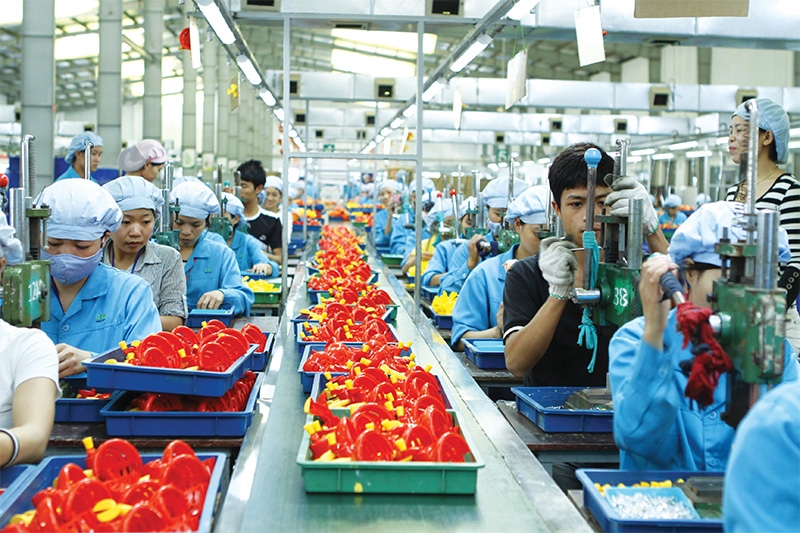Gliding over brief hush in FDI flows
 |
| FDI is flowing into sectors like manufacturing, despite the global recession, Photo: Le Toan |
In contrast to the grey picture of economic growth and foreign direct investment (FDI) attraction in Vietnam and over the world, the opening of Radial Jinyu Vietnam’s tyre manufacturing plant is a spotlight for the massive employment it brings.
Under the motto “Jinyu Young Talent”, the company has posted almost a hundred recruitment notices for engineers and other employees.
“We have received many applications and expect to finish headhunting this month and start manufacturing as soon as possible,” a representative of Jinyu Vietnam said.
In addition to the tyre manufacturing project invested by the Chinese investor in the southern province of Tay Ninh, Long Son Petrochemical Complex in Ba Ria-Vung Tau registered to expand capital by nearly $1.4 billion in April and started recruiting hundreds of engineers for the expansion.
These are two of the more than 2,500 newly-registered and capital expansion projects in the country in the first eight months of the year.
According to Do Nhat Hoang, director general of the Ministry of Planning and Investment’s (MPI) Foreign Investment Agency (FIA), these numbers are acceptable amid falling investment activities in the world and reaffirm Vietnam’s appeal to international investors.
In the World Investment Report 2020, the United Nations’ Conference on Trade and Development projected that global FDI flows would plunge 40 per cent this year from their 2019 value of $1.54 trillion, bringing them below $1 trillion for the first time since 2005. FDI is projected to decrease by a further 5-10 per cent in 2021 to start recovery in 2022.
In Vietnam, total newly-registered and added capital as well as capital contribution and share purchases by foreign investors in the first eight months was $19.54 billion, equalling 86.3 per cent of the year prior, and FDI disbursement was $11.35 billion, equivalent to 94.9 per cent. These results are lower than in the same period of the 2017-2019 period but better than in 2016 and previous years.
However newly-registered and added capital increased on-year. As many as 1,797 projects were granted investment certificates with total registered capital of $9.7 billion, up 7 per cent on-year, while 718 projects expanded by a total of $4.87 billion, up 22.2 per cent on-year.
Hoang also highlighted some new high-tech projects that can boost links in various economic sectors, as well as accelerate growth.
Of these, some new billion-dollar projects were licensed in the first months of the year like Singapore’s $4 billion liquefied natural gas-fired power plant, while Taiwan’s $273 million Victory Electronics factory in the northern province of Ha Nam and the $246 million high-end office for lease project of Singaporean investor in Hanoi added millions of US dollars in capital.
Over a week ago Prime Minister Nguyen Xuan Phuc issued Decision No.1318/QD-TTg guiding the operations of the task force on enhancing FDI attraction. In addition, the country is also considering resuming international flights.
The MPI has proposed four groups of solutions to promote investment, selectively attract FDI, improve the investment and business climate, and offer special incentives.
“These incentives will be detailed in legal documents stipulating that the prime minister or the government can approve outstanding incentives for individual projects or investors,” said Hoang. “The draft has been updated for comments from MPI units and will be submitted to MPI leaders this month and to the government next month. This is expected to fuel FDI performance.”
What the stars mean:
★ Poor ★ ★ Promising ★★★ Good ★★★★ Very good ★★★★★ Exceptional
Related Contents
Latest News
More News
- Stress laid on high-quality FDI inflows (December 15, 2025 | 11:00)
- Can Tho utilises its growth advantages (December 15, 2025 | 09:09)
- Ca Mau unlocking potential to shape a more sustainable future (December 15, 2025 | 09:02)
- Major projects to be inaugurated nationwide (December 15, 2025 | 08:00)
- MoF workshop highlights mounting concerns over ODA on-lending costs (December 12, 2025 | 16:05)
- National Assembly approves pilot mechanisms to accelerate major projects in Hanoi (December 12, 2025 | 11:29)
- Legislation gives government flexibility for loan guarantees (December 11, 2025 | 18:04)
- Vietnam eases policy approval requirements, simplifies foreign and outbound investments (December 11, 2025 | 17:53)
- Vietnam masters core technologies of automobile value chain (December 11, 2025 | 17:46)
- VAL opens second line of largest soybean crushing complex in Southeast Asia (December 11, 2025 | 12:08)

 Tag:
Tag:






















 Mobile Version
Mobile Version